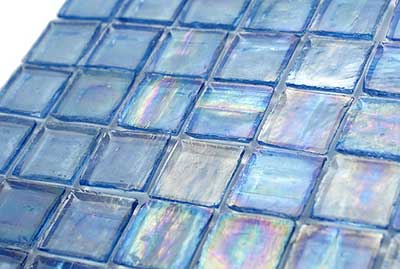Ceramic tiles have been around since the dawn of civilisation, but it wasn’t until around 2,500 BC that the Egyptians started using glass in mosaics. The Romans picked up the practice and, of course, improved it. The issue was obtaining the heat necessary to create molten glass. It takes 600C to melt glass, and to get it to a plasticity where you can work with it requires about 800C. These are temperatures that weren’t available until the third century BC.
After Rome fell, the practice of creating wall and floor mosaics from glass tiles fell to the Byzantines. Today, Byzantine Tiles, also known as smalti tiles, are still available, and they are made pretty much the same way the Byzantines created them 2,000 years ago.
‘Glass sandwich’ tiles
These small tiles are made in an artisanal process that could be described as a glass sandwich. Molten glass is mixed with various metal oxides to create a cloudy colour, and then is poured into forms. The result is a small tile (less than 2cm per side) that is fitted into a larger pattern. Expensive floors in many commercial buildings today use smalti tiles, and many of them contain decorative metals, including gold leaf.
When traditional-style glass tiles are manufactured, thin layers of molten glass are stacked on top of each other or over a decorative substance in a process called ‘fused glass’. The molten glass is then cooled in a controlled process that can take up to 12 hours. This is to ensure that the centre of the glass is the same temperature as the surface to avoid fracturing.
Today, glass kilns are generally electric and heating molten glass is much more precise than in the past, so there are newer, more flexible techniques that can be used.

New processes for an old product
In the 1990s, interest in glass tiles was revived when new processes, including the recycling of glass into tiles, created a strong demand for glass tiles. Around 20 years ago, manufacturers started to put a white coating on the glass that could receive heat transfer dyes. So now, photo-quality images can be printed right onto the glass tiles.
Glass is a great product for both wall and floor tiles. It may be brittle, but it’s tough, water proof and resistant to any kind of cleanser, even acid.
The latest fashion trends
What about recent fashion trends in glass tiles? Tiles are getting bigger to play down the grout lines. Three dimensional tile walls are becoming popular, with textured designs using hexagonal or other geometric shapes. Enamelled glass mosaics using matte and gloss tiles to form a pattern are also popular. New designs are bolder and more colourful than in the past. Iridescent tiles can capture light, making floors and walls shimmer.
You can sometimes find glass tile at our home renovation auctions. Keep an eye on the catalogues and videos if you’d like to find a bargain on great looking, stylish glass wall tiles for your kitchen or bath.
